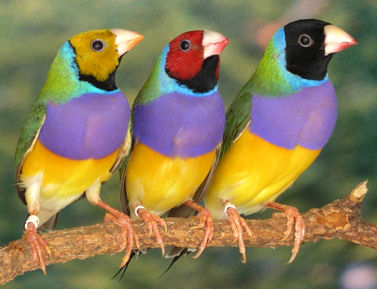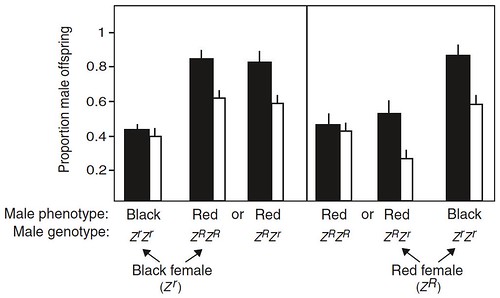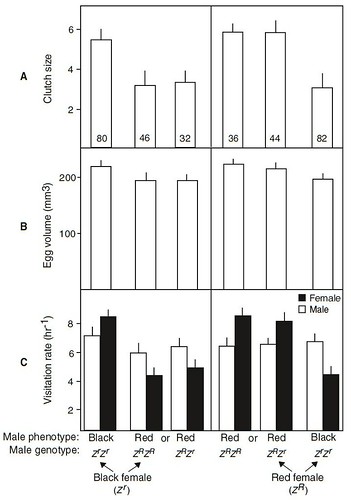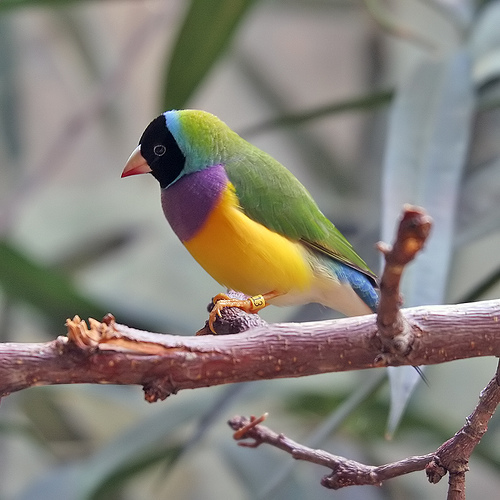tags: evolutionary biology, mate choice, sex determination, genetic compatibility, behavioral ecology, Gouldian Finch, Erythrura gouldiae, peer-reviewed paper
The three color morphs of Gouldian finches, Erythrura gouldiae.
Image: Sarah Pryke, Macquarie University.
Gouldian finches, Erythrura gouldiae, are small cavity-nesting passerines that are endemic to open savannahs adjacent to mangrove swamps in northern Australia. These finches eat a variety of native grass seeds, but to meet the increased energetic and nutritional demands of rearing chicks, they primarily eat insects when breeding. Gouldian finches are social birds that typically occur in large flocks in the wild. Invasive species, disease and habitat destruction have dramatically reduced their population so there currently are fewer than 2500 individuals remaining in the wild. But these beautiful birds are popular avicultural subjects so there is an active conservation and captive breeding program designed to preserve them.
Gouldian finches are known by a variety of common names; the Lady Gouldian Finch, Gould's Finch, or as the Rainbow Finch. Both sexes of this weaver-finch (family: Estrildidae) are strikingly colored with an olive green back and wings, a sharply pointed black tail, lemon yellow belly, purple breast, and a pale blue outline around their brightly colored heads. These birds were once thought to be three separate subspecies because of their distinct color polymorphisms, or "morphs" that occur naturally in the wild population.
"These colorful native birds have three possible head colors -- red, yellow and black," observed Dr. Sarah Pryke, a behavioral ecologist at Macquarie University in Sydney, Australia.
The plumage colors of these birds' heads is a genetic trait, with red being dominant to yellow, which is partially dominant to black. Further, red and black head colors are a sex-linked trait in Gouldian finches, and because birds have ZZ/Zw chromosomal sex determination, only the males (ZZ) can have two genes for red head color (homozygous), while females (Zw) can only ever have one gene for red head color (hemizygous). In contrast, yellow head color is an autosomal recessive trait, but is only ever fully expressed when the bird carries one copy of the red gene. In the absence of the red gene, birds that are homozygous for the yellow autosomal trait will have black heads and yellow-tipped beaks instead of the typical red-tipped beak.
As a result of this unusual and fascinating genetic color-coding system, a red-headed bird can produce offspring with either red, yellow or black head plumages; a yellow bird can also produce offspring with either red, yellow or black heads, while black morphs produce only black-headed chicks.
Interestingly, these three color morphs have distinct behavioral and hormonal profiles that affect their life histories. Both male and female red morph birds are very aggressive and thus end up with the best nesting cavities. Because red-headed birds have very high plasma testosterone concentrations, the male spends most of his time fighting instead of helping his mate raise their chicks. These elevated testosterone levels and high-stress lives compromise the birds' immune systems, making both males and females shorter-lived than individuals of the other color morphs.
Black-headed birds, which comprise approximately 70 percent of the wild population, are less aggressive than the red-heads, and have correspondingly lower testosterone levels. Black morphs usually lose the best nesting cavities to red morph birds, but the black morph males share chick rearing duties with their mates, and both sexes live longer.
The yellow-headed birds, which are very rare in the wild -- consisting of less than one individual per thousand -- are the pacifists in the flock. These birds avoid all aggressive interactions with both the red and black morphs and tend to experience great difficulty in retaining possession of suitable nesting hollows.
Based on these life history differences, it should not be surprising to learn that these color morphs are very important to mate choice: female Gouldian finches choose their mates based on the plumage color of the male's head. Further it has long been suspected that they also choose the sex of their chicks based on the color of their father's head.
The idea that females can bias the sex of their offspring based on external factors is not new. But researchers have found very little evidence to support this hypothesis that can't be explained by random fluctuations, according to Dr. Pryke. To test this possibility, Dr. Pryke and her colleague, Dr. Simon Griffith, designed an elegant series of experiments.
"Gouldian finches wear their genes on their head," remarked Dr. Pryke. "So it was relatively easy to construct an experiment to [test] the influence of head color on sex."
A female Gouldian finch chooses to breed with a male whose head plumage coloring matches hers because this is a visual indication that these males are a better genetic match. It is known that genetically incompatible pairs experience a 40.2% greater mortality of sons and an 83.8% greater mortality of daughters than in broods produced from genetically compatible matched pairs.
"Daughters produced from mixed matings -- where parents differ in head color -- suffer from genetic incompatibilities between their parents that cause about 84 per cent to die young," Dr. Pryke explained.
Unlike in mammals where the sperm determines the sex of each offspring, the sex of a bird's offspring is determined by the egg even before it is fertilized. Thus, when a female Gouldian finch is stuck with a mismatched male, she preferentially produces more male chicks because they are more likely to survive. Further, females in mixed pairs also reduce their energetic investment by producing fewer and smaller eggs.
"Females really don't want to mate with a male with a different head color," stated Dr. Pryke. "But there simply aren't enough compatible males, so later in the mating season they seem to use this control to make the best of a bad situation."
Since female Gouldian finches visually assess the phenotype of potential mates and because mixed-morph pairings are known to result in fitness costs, the researchers predicted that female Gouldian finches that are unable to pair preferentially with genetically compatible males should adjust their relative breeding investment accordingly.
To test this hypothesis, the scientists studied 200 female finches (100 black and 100 red) in a captive breeding colony established by the Save the Gouldian Fund at Martinsville in New South Wales' Hunter Valley. They bred each bird twice, once with each color morph and documented the sex of all the resulting chicks (figure 1);
Figure 1: Mean (+/-SEM) proportion of male offspring (laying to hatching) for each nest produced from within-female crosses between same (matched) and different (mixed) male morphs. Individual females given a male of a different genotype had offspring with a male-biased sex ratio (solid black bars). Even if we assume that all infertile eggs (of unknown sex) were female, a male-biased sex ratio remains (open bars). Although offspring from red females paired to heterozygous red males (i.e., genetically incompatible) suffered similar mortality rates as offspring from red-black pairings, in contrast to other incompatible mixed-morph pairs, red females in these matched pair crosses produced only a slight initial male bias (56%); if we assumed large differential female mortality in infertile eggs, these females would be predicted to produce very few male offspring. [larger view].
The researchers found that female Gouldian finches paired with mismatched males produced a tremendous preponderance of male chicks (82.1 percent), whereas females in matched pairs produced nearly equal numbers of both sexes (45.9 percent males).
The researchers then tested whether the females in mixed pairs were deliberately over-producing sons or if the high number of male chicks was the result of increased mortality among female chicks. To do this, they deceived female red and black morph birds into thinking they were mating with a black morph male. They did this by temporarily blackening the head feathers of red-headed males with a non-toxic dye and then pairing these disguised males with unsuspecting red and black morph females.
"It's actually quite hard to tell the experimentally blackened birds apart from natural black males," stated Dr. Pryke (figure 2);
Figure 2: Within-female differential investment when paired with the same (matched) and different (mixed) color morph. Females paired to a male of the same phenotype produced (A) 40.2% larger clutches, (B) 12.8% larger eggs, and (C) increased per capita provisioning of their offspring (46.1%) compared with when they were paired with a genetically incompatible male. The means +/-SEM (error bars) are shown, and brood sample sizes are provided in the bars of (A). [larger view].
The results of this experiment indicate that the female finches were fooled, too. Black morph females paired to the blackened red-headed males produced roughly equal numbers of male and female chicks. In contrast, red morph females paired with blackened red-headed males over-produced sons at a similar ratio to that found in the previous mixed pairing experiments.
This elegant series of studies reveals that female birds actually do choose the sex of their offspring, and further, they also show that it's not genetics that influences this gender bias, it's what the females actually see that counts.
"This is the clearest and perhaps most extreme example of sex biasing that has been found," said Dr. Pryke. "It's really black and white -- or in this case, black and red."
But these studies raise yet more intriguing questions: how do the female finches recognize the sex of each egg cell before it is fertilized? How does her body preferentially select male egg follicles to be fertilized? How do the female finches know what color their own heads are? And further, how did this peculiar breeding system become established in the first place?
These research findings also have important conservation implications. As the endangered Gouldian Finch population further decreases, the number of mixed pairings may increase, potentially leading to a dramatically unbalanced sex ratio in the breeding population. As a result, "we may lose one or other morph and the species as we know it," warned Dr. Pryke.
"So this makes us aware that small populations are a problem. Unless we increase the connections between populations, Gouldian finches are likely to go extinct a lot quicker."
Sources:
Pryke, S., & Griffith, S. (2009). Genetic Incompatibility Drives Sex Allocation and Maternal Investment in a Polymorphic Finch Science, 323 (5921), 1605-1607 DOI: 10.1126/science.1168928.





Beautiful photos and a great post.
That's fascinating! And I've never seen such beautiful finches.
What gorgeous little birds!
Does anyone have an idea what the (biochemical/cellular) mechanism of sex selection might be?
That is a wonderful, super elegant study. Man, I wish I could do such work.
octopod -- the mechanism for selecting egg follicles with the proper sex chromosome is not known. i'd guess that this is a potential nobel prize winning research project.
I saw the Catalyst program last night in which Dr Pryke's work was featured -- quite fascinating! Great work!
There has been similar study done recently on Western Bluebirds. I saw the prime researcher (another kickass grrl scientist)give a visiting presentation at the University of Montana. Wish I could remember her name. They discovered some very interesting details about how the female bird can determine the sex of her offspring. It's worth sleuthing out if you haven't already seen/read it.
There has been similar study done recently on Western Bluebirds. I saw the prime researcher (another kickass grrl scientist)give a visiting presentation at the University of Montana. Wish I could remember her name. They discovered some very interesting details about how the female bird can determine the sex of her offspring. It's worth sleuthing out if you haven't already seen/read it.
thanks for the suggestion. i will be doing just that! it sounds absolutely fascinating.